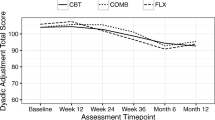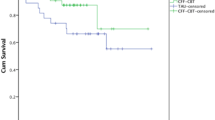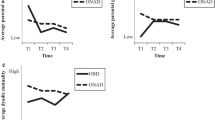Abstract
Evidence suggests that parental marital discord contributes to the development of internalizing and externalizing symptoms in children and adolescents. Few studies, however, have examined the association between parental marital discord and youth’s response to treatment. The present study examined the impact of interparental discord on treatment response in a randomized control trial of adolescents with major depression enrolled in the Treatment for Adolescents with Depression Study (TADS). Participants were 260 adolescents from two-parent households randomly assigned to one of four treatment groups: fluoxetine (FLX), cognitive behavior therapy (CBT), their combination (COMB), or placebo (PBO). Logistic regressions revealed that parental marital discord interacted with youth gender and co-morbid oppositionality symptoms to predict group differences in treatment response.



Similar content being viewed by others
References
American Psychiatric Association. (1994). Diagnostic and statistical manual of mental disorders (4th ed.). Washington: American Psychiatric Association.
Anant, S., & Raguram, A. (2005). Marital conflict among parents: implications for family therapy with adolescent conduct disorder. Contemporary Family Therapy: An International Journal, 27(4), 473–482.
Becker-Weidman, E. G., Jacobs, R. H., Reinecke, M. A., Jordan, N., Silva, S. G., Rohde, P., et al. (2008). Oppositionality outcomes among adolescents treated for depression. Paper presented at the 55th annual meeting of the American Academy of Child and Adolescent Psychiatry, Chicago, October.
Buehler, C., Anthony, C., Krishnakumar, A., Stone, G., Gerard, J., & Pemberton, S. (1997). Interparental conflict and youth problem behaviors: a meta-analysis. Journal of Child and Family Studies, 6(2), 233–247.
Butler, A. C., Chapman, J. E., Forman, E. M., & Beck, A. T. (2006). The empirical status of cognitive-behavioral therapy: a review of meta-analyses. Clinical Psychology Review, 26(1), 17–31.
Clark, D. A., Beck, A. T., & Alford, B. A. (1999). Scientific foundations of cognitive theory of depression. New York: Wiley.
Conners, C. K. (1997). Conners’ rating scales—revised: Users manual. Tonawanda: Multi-Health Systems.
Conners, C. K., Sitarenios, G., Parker, J. D. A., & Epstein, J. N. (1998). The Revised Conners’ Parent Rating Scale (CPRS-R): factor structure, reliability, and criterion validity. Journal of Abnormal Child Psychology, 26(4), 257–268.
Crawford, T. N., Cohen, P., Midlarsky, E., & Brook, J. (2001). Internalizing symptoms in adolescents: gender differences in vulnerability to parental distress and discord. Journal of Research on Adolescence, 11(1), 95–118.
Cui, M., Conger, R. D., & Lorenz, F. O. (2005). Predicting change in adolescent adjustment from change in marital problems. Developmental Psychology, 41(5), 812–823.
Cummings, E. M., Goeke-Morey, M. C., & Papp, L. M. (2004). Everyday marital conflict and child aggression. Journal of Abnormal Child Psychology, 32(2), 191–202.
Curry, J., Rohde, P., Simons, A., Silva, S., Vitiello, B., Kratochvil, C., et al. (2006). Predictors and moderators of acute treatment outcome in the treatment for adolescents with depression study (TADS). Journal of the American Academy of Child and Adolescent Psychiatry, 45(12), 1427–1439.
Dadds, M. R. (1992). Concurrent treatment of marital and child behaviour problems in behavioural family therapy. Behaviour Change, 9(3), 139–148.
Dadds, M. R., & Powell, M. B. (1991). The relationship of interparental conflict and global marital adjustment to aggression, anxiety, and immaturity in aggressive and nonclinic children. Journal of Abnormal Child Psychology, 19(5), 553–567.
Dadds, M. R., Schwartz, S., & Sanders, M. R. (1987). Marital discord and treatment outcome in behavioral treatment of child conduct disorders. Journal of Consulting and Clinical Psychology, 55(3), 396–403.
Davies, P. T., & Cummings, E. M. (1994). Marital conflict and child adjustment: an emotional security hypothesis. Psychological Bulletin, 116(3), 387–411.
Davies, P. T., & Lindsay, L. L. (2004). Interparental conflict and adolescent adjustment: why does gender moderate early adolescent vulnerability? Journal of Family Psychology, 18(1), 160–170.
Emery, R. E. (1982). Interparental conflict and the children of discord and divorce. Psychological Bulletin, 92(2), 310–330.
Essau, C., & Dobson, K. (1999). Epidemiology of depressive disorders. In C. Essau & F. Peterman (Eds.), Depressive disorders in children and adolescents: Epidemiology, course and treatment (pp. 69–103). Northvale: Jason Aronson.
Feeny, N. C., Silva, S. G., Reinecke, M. A., McNulty, S., Findling, R. L., Rohde, P., et al. (2009). An exploratory analysis of the impact of family functioning on treatment for depression in adolescents. Journal of Clinical Child and Adolescent Psychology, 38(6), 814–825.
Fergusson, D. M., & Woodward, L. J. (2002). Mental health, educational, and social role outcomes of adolescents with depression. Archives of General Psychiatry, 59, 225–231.
Graham, J. M., Liu, Y. J., & Jeziorski, J. L. (2006). The dyadic adjustment scale: a reliability generalization meta-analysis. Journal of Marriage and Family, 68, 701–717.
Guy, W. (1976). ECDEU assessment manual for psychopharmacology (2nd ed.). Washington: US Government Printing Office.
Jenkins, J., Simpson, A., Dunn, J., Rasbash, J., & O’Connor, T. G. (2005). Mutual influence of marital conflict and children’s behavior problems: shared and nonshared family risks. Child Development, 76(1), 24–39.
Kraemer, H. C., Wilson, G. T., Fairburn, C. G., & Agras, W. S. (2002). Mediators and moderators of treatment effects in randomized clinical trials. Archives of General Psychiatry, 59, 877–883.
Lewinsohn, P. M., Hops, H., Roberts, R. E., Seeley, J. R., & Andrews, J. A. (1993). Adolescent psychopathology I: prevalence and incidence of depression and other DSM-III-R disorders in high school students. Journal of Abnormal Psychology, 102, 133–144.
Lindahl, K. M., & Malik, N. M. (1999). Marital conflict, family processes, and boys’ externalizing behaviors in Hispanic American and European American families. Journal of Clinical Child Psychology, 28(1), 12–24.
Lorenz, G., Hoven, C., Andrews, H. F., & Bird, H. (1995). Marital discord and psychiatric disorder in children and adolescents. Journal of Child and Family Studies, 4(3), 341–358.
McCleary, L., & Sanford, M. (2002). Parental expressed emotion in depressed adolescents: prediction of clinical course and relationship to comorbid disorders and social functioning. Journal of Child Psychology and Psychiatry, 43(5), 587–595.
Petersen, A. C., Compas, B. E., Brooks-Gunn, J., Stemmler, M., Ey, S., & Grant, K. E. (1993). Depression during adolescence. The American Psychologist, 48, 155–168.
Poznanski, E. O., & Mokros, H. B. (1996). Children’s Depression Rating Scale, Revised (CDRS-R)—manual. Los Angeles: Western Psychological Services.
Reid, W. J., & Crisafulli, A. (1990). Marital discord and child behavior problems: a meta-analysis. Journal of Abnormal Child Psychology, 18(1), 105–117.
Reyno, S. F., & McGrath, P. J. (2006). Predictors of parent training efficacy for child externalizing behavior problems—a meta-analytic review. Journal of Child Psychology and Psychiatry, 47(1), 99–111.
Reynolds, W. M. (1987). Reynolds adolescent depression scale: Professional manual. Odessa: Psychological Assessment Resources.
Rohde, P., Silva, S. G., Tonev, S. T., Kennard, B. D., Vitiello, B., Kratochvil, C. J., et al. (2008). Achievement and maintenance of sustained response during the treatment for adolescents with depression study continuation and maintenance therapy. Archives of General Psychiatry, 65(4), 447–455.
Schermerhorn, A. C., Cummings, E. M., DeCarlo, C. A., & Davies, P. T. (2007). Children’s influence in the marital relationship. Journal of Family Psychology, 21(2), 259–269.
Snyder, J. R. (1998). Marital conflict and child adjustment: what about gender? Developmental Review, 18, 390–420.
Spanier, G. B. (1976). Measuring dyadic adjustment: new scales for assessing the quality of marriage and similar dyads. Journal of Marriage and the Family, 38, 15–28.
Spence, S. H., Najman, J. M., Bor, W., O’Callaghan, M., & Williams, G. M. (2002). Maternal anxiety and depression, poverty and marital relationship factors during early childhood as predictors of anxiety and depressive symptoms in adolescence. Journal of Child Psychology and Psychiatry, 43(4), 457–470.
The Treatment for Adolescents with Depression Study Team. (2003). Treatment for adolescents with depression study (TADS): rationale, design, and methods. Journal of the American Academy of Child and Adolescent Psychiatry, 42(5), 531–542.
The Treatment for Adolescents with Depression Study Team. (2004). Fluoxetine, cognitive-behavioral therapy, and their combination for adolescents with depression: treatment for adolescents with depression study (TADS) randomized controlled trial. Journal of the American Medical Association, 292(7), 807–820.
Turner, C. M., & Dadds, M. R. (2001). Clinical prevention and remediation of child adjustment problems. In J. H. Grych & F. D. Flincham (Eds.), Clinical prevention and remediation of child adjustment problems (pp. 387–416). New York: Cambridge University Press.
Walker, J. G., Manion, I. G., Cloutier, P. F., & Johnson, S. M. (1992). Measuring marital distress in couples with chronically ill children: the dyadic adjustment scale. Journal of Pediatric Psychology, 17(3), 345–357.
Zimet, D. M., & Jacob, T. (2001). Influences of marital conflict on child adjustment: review of theory and research. Clinical Child and Family Psychology Review, 4(4), 319–335.
Author information
Authors and Affiliations
Corresponding author
Rights and permissions
About this article
Cite this article
Amaya, M.M., Reinecke, M.A., Silva, S.G. et al. Parental Marital Discord and Treatment Response in Depressed Adolescents. J Abnorm Child Psychol 39, 401–411 (2011). https://doi.org/10.1007/s10802-010-9466-2
Published:
Issue Date:
DOI: https://doi.org/10.1007/s10802-010-9466-2




